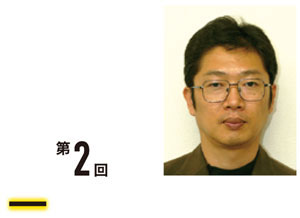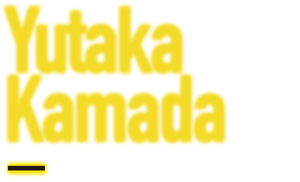The Archive of the Class
The 1st Part: CG Animation Cup: Japan vs. EU Simulation Match (14:00 to 16:00)
In the 1st part of the class, a simulation match between Japan and EU was held. The match was hosted by the representative of the NPO Project DoGA, Mr. Yutaka Kamada, and Yuka Imabayashi, a student of Department of Animation, Graduate School of Film and New Media, Tokyo University of the Arts, who has participated in the CG Animation Cup before.

Prof. Okamoto making the opening speech.
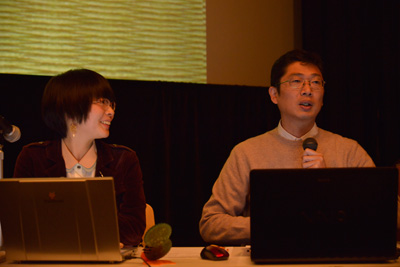
From right, Mr. Yutaka Kamada and Yuka Imabayashi as the hosts of the game.
♦ Competition Rules
The game between two teams consists of five matches from Senpo (the first player) to Taisho (the last player) similar to a team competition of Judo. Each team screens a piece of animation in each match and the superior animation is chosen by the judges. The teams prepare five animations before the day of the match. And during the match the teams discuss and decide which piece should be screened in which match. The outcome of a game is largely dependent upon this decision.
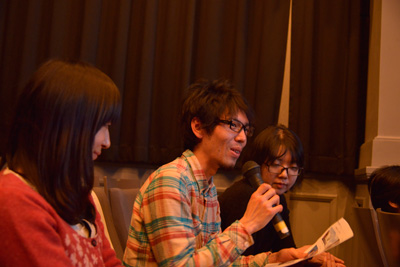
The representative of Japan team announcing the title to screen.
♦ The Screening
After deciding the piece to screen in the match, the representative of the team announces the title and the reason why they choose it.
Once the screening of Japan team finishes, EU team decides their piece to counter and announces it. Appeals from the creators are also screened after the screening of both teams' animations.
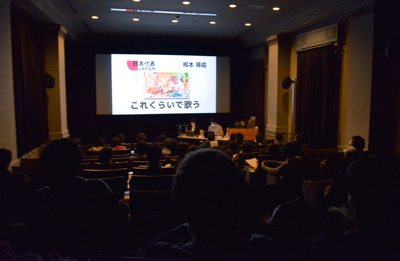
Screening of the animation.
♦ "Hakushu-kun" (lit. Mr. Applause)
At the CG Animation Cup, the winner is not only decided by the judges but also by the audience's applause. CG Animation Cup introduced a system called "Hakushu-kun" (lit. Mr. Applause) which measures and judges the volume of the applause right away after screening. So the audience are supposed to make loud sounds by clapping or cheering when they like the screened animation. But you should be careful because if you boo when you don't like it, that counts as a score. "Hakushu-kun" only measures the sound level for about five seconds while the sign of "measuring" is displayed on the screen.

"Hakushu-kun" measuring the applause.
♦ Judgment and the Outcome of the Game
The jury judges both the animation itself and the creators' appeal. A jury raises a red light if s/he concludes Japan team has won, and a blue light if EU team has won. The volume of the audience's applause is also measured and the result is displayed on the screen. Based on these two judgments, the final outcome of the match is displayed. Then the jury make some comments.
The teams play five matches in total - Senpo, Jiho, Chuken, Fukusho, and Taisho Matches – and the team who wins three matches or more is the winner.
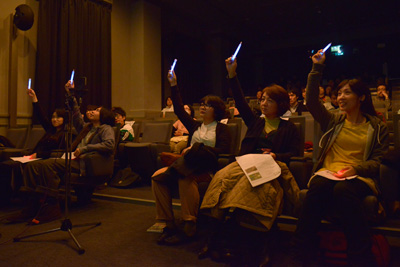
The jury making judgment.

The jury's judgment result on the screen.
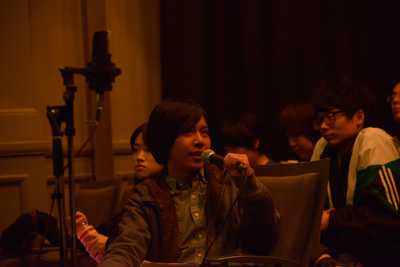
A juror making comments.
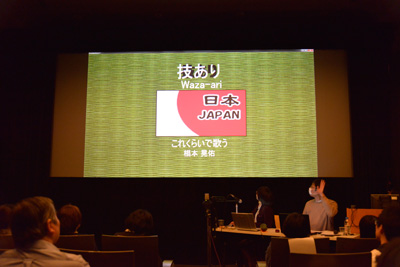
The judgment result.

The winner is…
In the simulation match this time, Japan team won the victory.
The 2nd Part: A Journey from the Dawn of CG animation to CG Animation Cup (16:15 to 17:45)
Mitsuko Okamoto: I've been waiting for this opportunity to ask a lot to Mr. Kamada, the representative of DoGA, which has been holding "CG Animation Contest" for 24 years based in the Kansai region. First off, how has this CG Animation Contest lasted for a whole 24 years and why has it become the center of the network of independent animation creators? How do you run the CG Animation Cup or CG Animation Contest, or Doga itself? I hope we can find the answers to some of these secrets today.
Yutaka Kamada: Today I would like to mention producer's works while introducing the actual cases of various projects we have worked on since we founded DoGA
I was a junior student of Osaka University and belonged to a computer club in 1985 when I established DoGA. Before that, I joined in the making of an independent film when I was in the last grade of high school and that got me interested in filmmaking. I wanted to be a filmmaker and actually made some films for a while.
But this was thirty years ago and the environment and the technology for filmmaking were totally different from nowadays. It was the age of 8 mm film and no video camera existed yet. If you wanted to make a live-action film, you couldn't make it unless you could gather a large cast and staff with actors, cameramen, and production managers.
Making a film is much more fun than seeing it, but it was too hard to make it at that time. I thought that if we made it easier, anybody would create films and a new visual culture may appear, which would differ from conventional TV shows or theatrical movies. That was the background for which I founded DoGA.
♦ Producer and a Sense of Purpose
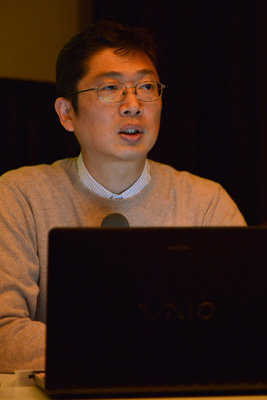 I've just introduced the aim of DoGA and now, to begin with, I tell you that a producer must have a clear goal in mind. This can be applied not only to visual production but also to producing any project or event in general.
First, a clear goal is easy to understand and easy to communicate. I sometimes see films or events which I cannot get what they are trying to do and I think that may be because the goal or concept strayed at the stage of planning.
Second, the achievement will be clear. If you set a clear goal, it will naturally be clear too whether you achieve it or not. Conversely, you cannot succeed in a project with a goal which is too grand and vague.
Finally, a clear goal makes a producer free from being lost. Because even when a problem happens, all you have to do is just make decisions based on if it suits the goal.
You may have an impression that producers are always under pressure to make difficult decisions, but in fact I rarely waver among the options in planning and carrying out an event. When someone asks me something, I will usually answer right away. If they need specific information or knowledge for making a decision, I tell them to ask such and such person. Even in the case where the difference of the options seems to be quite subtle, I usually say, "it should be A, of course" at once. Especially in such a case, as it causes very little difference after all no matter which you choose. It is wavering in choosing which brings demerits. If you are at a loss and cannot make decision, it makes those around you worried and the delay in making decision leads to the delay in production. That causes huge demerits. So you need to make immediate decisions and prepare for some criticism.
In this way, it is very important for a producer to be purposeful in order to communicate the aim to the target, define the possibility of success and achieve it, or for the producer him/herself to make decisions.
♦ A long Journey from the Dawn of DoGA to Starting CG Animation Production
Let's go back to the time when I founded DoGA. If I had just declared that I would create a new visual culture, I was nothing but an ordinary student and it would sound as thoughtless and absurd as declaring all of a sudden, "I'm going to be the king of pirates!"
But I had an innovative idea to make filmmaking easier. Which was to use personal computers. If you construct a system where a PC automatizes all the actors and cameramen and plays all the roles as cameras, editing equipment, a projector and so on, anyone can easily make videos by oneself. That is, CG animation.
You probably it's not much of a secret since it is so common to use PC in filmmaking. People tend to say, "It will never happen" before you realize something, though they say "Oh, it's no surprise" after you've done it.
In the middle of the 1980s, CG animation such as Disney's Tron in 1982 which was called the world's first full-blown CG animation, cost tens of millions yen per one-second cut and was the kind of production only big business or a small group of laboratories could make. So to use CG in an indie film was as likely as casting Tom Cruise in an indie film. Nobody had such bare ideas at that time. First of all, PC performance was far lower than that of today. Sharp's X68000 was regarded as a quite hi-spec PC at the time though it had only 1 megabyte of main memory. In addition, there were only floppy disks instead of hard disks and so we had no place to stock the cuts. Given this environment, it was pretty wild to think of making videos easily with your own PC.
It was in 1985 when I made a real CG animation for the first time. I made it with a 8mm film camera by a kind of stop motion method like a clay animation but this was not the level anyone could readily try.
There was of course problems not only in hardware but also in software. Initially, software for making CG animation didn't exist at that time. So I thought WE should make it since no one else did. I started working on the development of the first Japanese CG production software for the PC as soon as I founded DoGA. Making a whole big system takes too much time to complete, so we made it an assembly of small applications which forms a system of division of labor. We made animation pieces in parallel with developing the system and that stimulated the motivation to develop the program, accelerated the improvement of it, and therefore the utility was enhanced.
Since the aim of the establishment of DoGA was to make it possible for everybody to create CG, we developed the software on the assumption that people outside of DoGA would also use it and so we standardized the manual's format.
In addition, I started a serial in a PC magazine when we set to work on the development, in order to prepare a place to present the finished software. I think it means a lot that our software got recognized by tens of thousands of readers very soon and they actually used it.
A Proposal to the Creators of Digital Generation was the title of my serial. Which meant I proposed new visual production using a PC. Hopefully now I've given you a small glimpse of our long long journey to challenge the development of CG animation production systems for the PC.
We also developed a generic multi-window system to classify and display CG animation pieces. I think in total we made about 100 kinds of applications including those we made just for fun. We distributed them in floppy disks as the supplements of the magazine which I was writing the serial for. They were probably some of the first Japanese freeware. As a result, the users of our CGA system had kept accounting for 70 to 80 percent of all CG creators in Japan for a while. Those users were really content and they donated tens of millions of yen to us. So we decided to incorporate DoGA which we had continued doing as an extension of our club activity in college and realized it in 1993. We first tried to make it a non-profit organization but eventually made it a stock company because the NPO Law did not exist yet.
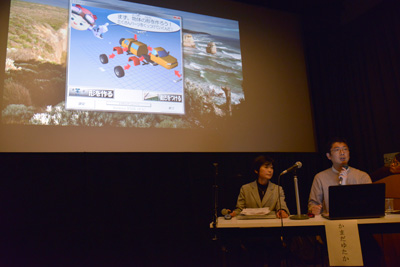
♦ What are the Qualifications to be a Producer?
Though I've talked like I did everything, I didn't actually touch the development of our CGA system at all. All we did was to define the goal clearly; persuade the club members to join the project; negotiate for running the serial with the publisher; prepare a room for us to work; run the project with a fee for the serial; negotiate the donation of personal computers for development with PC manufacturers; examine the specification of the system; make the manuals; and write a series of articles in the magazine. In brief, what I did was mostly chores and I think that is what producing is.
There is a difference between creators and producers. Creators realize what they can do by themselves. Producers realize what they cannot do in cooperation with a lot of people.
So producers must move many people and therefore human networking is very important for us. One of the qualifications to be a producer is having people around him/herself, who would say, "I take it on because that is YOUR project" or "I cannot say no when YOU ask me to do."
Another of the qualifications is to be good. If someone talked about you like "He gave me the shaft. I'll never work with him again." when you've done a project, the network would be severed each time and that would lead to limiting what you can do. On the other hand, there are in fact quite a few crooked producers who give priority to their own profits and deceive people. So just because you hear good things about someone doesn't mean that s/he is truly nice, but I hope we can believe that.
Those who are diligent, obliging, and quick-witted are well suited to be a producer too. A producer has to do many miscellaneous duties and generally becomes a caretaker of creators in the end.
A master of none will also do. A master of something is qualified to be a creator. I once wanted to be a filmmaker and was a sort of creator. But I knew I didn't have a genuine talent and so I have worked as a producer partly because I think it is better to take care of talented creators in order to produce a lot of excellent pieces into the world.
In other words, I think it is worth considering converting to producing if you realize that there are so many more talented people than you in college and that it is impossible for you to make a living as a creator in the future. In that case, you can be a good producer since you will naturally be able to build a network of talented creators and you can understand their pleasure and pain as an ex-creator.
A person with ideas is qualified too. The process of trial and error is full of errors. When trouble happens, a producer needs to be capable of figuring out any alternative plan instead of giving up.
Finally, the ability to raise funds is also required. Though I am bad at fund raising, I would like you to be a good fundraiser when you become a producer.
♦ The Start of CG Animation Contest
Let's go back to the activity of DoGA again. We proceeded the development of CGA system as I've told you but there was no chance to present the work created with that system. We didn't think that made any sense so we decided to start a CG Animation Contest. We expected that everybody would create animations with the contest as a goal if we announced we were going to hold one. At the first contest, most of the participants were from our peers and the standard of evaluation was so low that anything could be prized as long as it moved in CG. I had the PC magazine where I ran a series of articles feature the results of the contest in full color and then from the next year we received more and more applications from outside of our family circle.
At the beginning, CG Animation Contest mainly played a role as a showcase of the achievements of various groups. Many of the applicants were from the science field. But after a while, those who were from humanities started to use PCs and then CG animations with sophisticated stories appeared. And from around the time when 10 years had passed since we started this contest, students of art colleges joined one by one and pieces with artistic sense increased. In this way, the number of the applicants rose every year and the quality of the works improved.
The public recognition of indie CG animation was quite poor, however. People assumed as usual that CG was something very expensive only to use in the theatrical movies. Whenever we showed them indie CG animation made with a PC, they reacted like "Huh, you can use PCs to make CG animation," or "Kinda cheap." We ourselves always showed the pieces making excuses like "since they were made with a PC…" or "because it was created by amateurs…" We had been asked for long like "Why do you want to make your own films on a PC?" or "What the hell is the point?"
So the aim of CG Animation Contest at that time was to catch up with indie live-action films; to let people know the existence of this genre; not to let people ask what the point is; and to show the works without the excuse of being amateurs. These were some of the aims of our contest.
But the public recognition changed at a stroke when Mr. Makoto Shinkai released Voices of a Distant Star. Owing to his work, people's attitude towards CG animation and CG creators has changed and they started to say that it is a key industry of Japan and that it is necessary to develop the human resources for this genre.
While CGA system and CG Animation Contest respectively had a clear vision, CG Animation Cup which I introduced in the first part of this class was a collective body of various ideas.
♦ How could we carry on DoGA?
I would like to talk about the management of DoGA. Our activity is in the red basically. But we are doing system development work apart from CG all the time and invest the profits generated from such work into the non-profit activities. We cannot make money at all from promoting CG animation, and on top of that, it has brought us numerous failures and awful troubles one after another. Nevertheless, I was able to carry on for nearly 30 years despite the lack of high motivation or an undying spirit and while suffering many failures.
Curiosity – this is my simple motivation. The initial aim of founding DoGA was my desire to make it possible to make the videos that I wanted to make even though I couldn't do at that time.
Regarding CG Animation Cup, I hit upon an idea of the CG animation Olympics, a world team competition and once I thought I found the way to realize it, I couldn't help trying.
So I believe that you should be motivated by what you really want to do if you are going to be a producer. To do something just because someone told you to, such motivation makes you unhappy and produces nothing good. If you want to make money, make it your motivation and try hard. "For the world, for the people" makes for a good cause too but if it is the one and only motivation, that would be limiting.
Fortunately, the work of a producer is full of dreams. To produce is to make your dream come true. So please begin by searching for your own dream like what you want to do or what you want to be able to do.
Okamoto: Thank you very much. I'm deeply impressed by your words that producers should be good. You offer some very educational programs for the creators who participated in CG Animation Contest and provide an education relating to copyright.
Kamada: Because creators cause troubles relating to the contract all the time. What we see frequently is, for example, the creator makes a contract to give a specific company his/her first business right and therefore s/he becomes unable to work unless it is through that company. So I held seminars to study the knowledge of law and contracts or troubles over copyright and I invited legal professionals to speak. I told the participants each time that they should come talk to us not after but before they sign the contract.
Okamoto: You are so "good" as to repeatedly caution creators to be very careful since even some contests impose the prize winners the conditions that they shall give their screening right to the contest. Why do you support individual artists especially?
Kamada: Since I wanted to be a creator myself, I feel as if the winners of the CG Animation Contest are my juniors from the club at college. I regard them as my juniors who belong to the same big club to make CG animation and therefore I naturally support their activities. This is the picture I have in my head.
Okamoto: Let me ask some questions about the CG Animation Cup. I heard that the total viewers of the CG Animation Cup on Nico Nico-dōuga amounted to a hundred thousand. This is quite a number. I was surprised because it has already attracted a hundred thousand viewers despite the CG Animation Cup being an event with such a short history.
Kamada: We were surprised too. But it doesn't mean we will be able to get two hundred thousand viewers next year. However hard we may try, it will reach 120 thousand viewers at the most. So I would like to broadcast the contest on television so that a much larger audience can watch it.
Okamoto: On television, they don't air something dark like the work screened in the simulation match today or the work where people are mangled. Though the edged and artistic pieces are the thrill of the CG Animation Cup, they may become innocuous if they are to be aired on television.
Kamada: Then I would make two different versions – the television version and the Nico Nico-dōuga version. I think it is naturally possible that different pieces would be chosen according to the media.
Okamoto: I believe that we need to educate the audience in addition to creators because good audiences foster good creators. And I think that the CG Animation Cup practically educates the audience through the system where the audience joins the judgment by measuring the volume of their applause. If each of the audience members becomes conscious of his/her responsibility as a juror, everybody will watch the works more seriously indeed.
Kamada: To think about what kind of animation is good for themselves leads to the direction of the work they should make. So it is one of the aims of the CG Animation Cup that all the audience participate in the judgment. We do value the process of that evaluation by each audience member but make little account of the result itself. That's why we don't give any prize money to the winning team.
Okamoto: Each student of our graduate school makes one animation a year and we feel it is difficult to decide who is the winner or the loser. In addition to the problems in the evaluation criteria, I think creators don't want to be judged which is better.
Kamada: I think they should bestir to make a better piece next time if they were judged as the loser. To us, the students of Tokyo University of the Arts seem to be protected very much and this is not a compliment. I'm worried if they will get on well after graduation. If they lost motivation when compared with others and lose, they won't be able to survive the real world.
Okamoto: You've concluded your story with remarking that curiosity is your motivation. Do you have any specific future plans?
Kamada: I have worked for 30 years and feel that I have done many of my plans concerning the environment around creators. But I still think of what to do not only for producing one great creator from 1,000 people but also for the remaining 999. Visual culture was one-way traffic from the professional to the public. But I imagined the future where many more people would be able to use videos to express what they wanted to say and videos would be the means of interactive communication, and then the genuine visual power would be displayed finally and cultivate a new industry or new culture. So I would like to focus on a project to expose and familiarize everybody with CG animation from childhood.
Okamoto: I feel like the entire puzzle was solved today by the idea that all the directors of short animation in Japan are belonging to the same club. Thank you very much.
| 